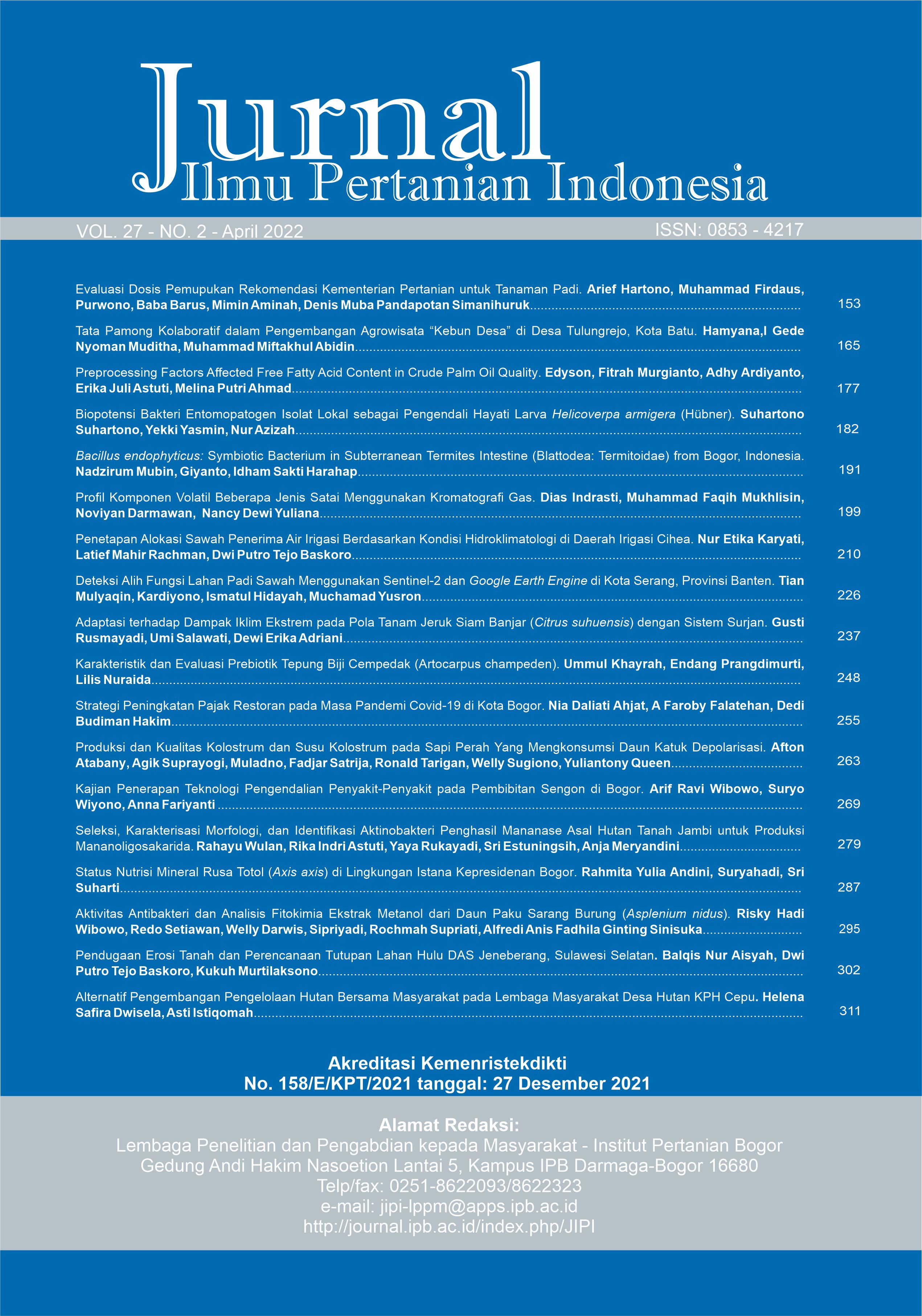Seleksi, Karakterisasi Morfologi, dan Identifikasi Aktinobakteri Penghasil Mananase Asal Hutan Tanah Jambi untuk Produksi Mananoligosakarida
Abstract
As the world's largest producer of crude palm oil, Indonesia also produces high palm kernel cake (PKC) by-products. PKC has a high mannan content, so it can be used to produce prebiotic mannan-oligosaccharides (MOS). Enzymatic MOS production can be carried out using actinobacterial mannanase's microbiological approach. The HJ45B-1 isolate was the best isolate, with a peak enzyme production of 0,338 U/mL on the 10th day of incubation. The mannanase enzyme was stable in storage at 27°C. MOS production using 1% PKC substrate produced MOS with the best degree of polymerization (2-4) with incubation for 1-3 hours. Morphological characteristics and molecular identification based on the 16S rRNA gene indicated that the HJ45B-1 isolate was Streptomyces spp.
Keywords: actinobacteria, mannanase, mannan-oligosaccharides, palm kernel cake, Streptomyces
Downloads
References
Ariandi, Yopi, Meryandini A. 2015. Enzymatic hydrolysis of copra meal by mannanase from Streptomyces sp. BF3.1 for the production of mannooligosaccharides. HAYATI Journal of Biosciences. 22(2): 79–86. https://doi.org/ 10.4308/hjb.22.2.79
Azizi MN, Loh TC, Foo HL, Chung ELT. 2021. Is palm kernel cake a suitable alternative feed ingredient for poultry? Animals. 11(338): 1–15. https:// doi.org/10.3390/ani11020338
Baurhoo B, Phillip L, Ruiz-Feria C. 2007. Effects of purified lignin and mannan oligosaccharides on intestinal integrity and microbial populations in the ceca and litter of broiler chickens. Poultry Science. 86(6): 1070–1078. https://doi.org/10.1093/ps/ 86.6.1070
Bada Pusat Statisti [BPS.] 2020. Indonesian Oil Palm Statistics 2019. Statistics S of EC, editor. Jakarta (ID): BPS-Statistics Indonesia.
Cerveró JM, Skovgaard PA, Felby C, Sørensen HR, Jørgensen H. 2010. Enzymatic hydrolysis and fermentation of palm kernel press cake for production of bioethanol. Enzyme Microb Technoogyl. 46(3–4): 177–184. https://doi.org/ 10.1016/j.enzmictec.2009.10.012
Chater KF, Biró S, Lee KJ, Palmer T, Schrempf H. 2010. The complex extracellular biology of Streptomyces: review article. FEMS Microbiology Reviews. 34(2): 171–198. https://doi.org/ 10.1111/j.1574-6976.2009.00206.x
Downie B, Hilhorst HWM, Derek Bewley J. 1994. A new assay for quantifying endo-β-d-mannanase activity using congo red dye. Phytochemistry. 36(4): 829–835. https://doi.org/10.1016/S0031-9422(00)90446-1
Dubois M, Gilles KA, Hamilton JK, Rebers PA, Smith F. 1956. Colorimetric method for determination of sugars and related substances. Analytical Chemistry. 28(3): 350–356. https://doi.org/ 10.1021/ac60111a017
Evan S, Meryandini A, Sunarti TC. 2020. Characteristics of mannanase enzyme in actinomycetes isolated from Taman Nasional Bukit Duabelas Jambi. IOP Conference Series: Earth and Environmental Science. 457(1):1–9. https://doi.org/10.1088/1755-1315/457/1/012070
Gibson GR, Hutkins R, Sanders ME, Prescott SL, Reimer RA, Salminen SJ, Scott K, Stanton C, Swanson KS, Cani PD, et al. 2017. Expert consensus document: The International Scientific Association for Probiotics and Prebiotics (ISAPP) consensus statement on the definition and scope of prebiotics. Nature Reviews Gastroenterology & Hepatology. 14(8): 491–502. https://doi.org/ 10.1038/nrgastro.2017.75
Heuer H, Krsek M, Baker P, Smalla K, Wellington EMH. 1997. Analysis of actinomycete communities by specific amplification of genes encoding 16S rRNA and gel-electrophoretic separation in denaturing gradients. Applied and Environmental Microbiology. 63(8): 3233–3241. https://doi.org/10.1128/aem.63.8.3233-3241.1997
Inayah MN, ambarsari L, Meryandini A. 2016. Karakterisasi xilanase dari bakteri xilanolitik XJ20 asal tanah Hutan Taman Nasioanal Bukit Duabelas Jambi Indonesia. Jurnal Sumberdaya Hayati. 2(1): 25-30. https://doi.org/10.29244/ jsdh.2.1.25-30
Jana UK, Suryawanshi RK, Prajapati BP, Kango N. 2021. Prebiotic mannooligosaccharides: Synthesis, characterization and bioactive properties. Food Chemistry. 342(128328): 1–13. https://doi.org/10.1016/j.foodchem.2020.128328
Meryandini A, Anggreandari R, Rachmania N. 2008. Isolasi bakteri mananolitik dan karakterisasi mananasenya. Biota. 13(2): 82-88. https:// doi.org/10.24002/biota.v13i2.2675
Miller GL. 1959. Use of Dinitrosalicylic Acid Reagent for Determination of Reducing Sugar. Analytical Chemistry. 31(3): 426–428. https://doi.org/ 10.1021/ac60147a030
Mohapatra BR. 2021. Characterization of β-mannanase extracted from a novel Streptomyces species Alg-S25 immobilized on chitosan nanoparticles. Biotechnology & Biotechnological Equipment. 35(1): 150–161. https://doi.org/10.1080/13102818.2020.1858158
Nadia HAEN, El Sayed MM, Wafaa GS, Gehad HES. 2010. Purification and partial characterization of extracellular cellulase free xylanase from Streptomyces rochei. Journal of Applied Sciences Research. 6(9): 1373–1378.
Nejis NA, Heng JLS, Hassan R. 2011. Prescreening of bioactivities from actinomycetes isolated from forest peat soil of Sarawak. AGRIS. 39(2): 245–253.
Shilring E, Gottlieb D. 1966. Methods of characerization of Streptomyces species. International Journal of Systematic Bacteriology 16(3): 323–340. https://doi.org/10.1099/002 07713-16-3-313
Srivastava PK, Panwar D, Prashanth KVH, Kapoor M. 2017. Structural characterization and in vitro fermentation of β-mannooligosaccharides produced from locust bean gum by GH-26 endo-β-1,4-mannanase (ManB-1601). ournal of Agricultural and Food Chemistry. 65(13): 2827–2838. https://doi.org/10.1021/acs.jafc.7b00123
Tamura K, Stecher G, Peterson D, Filipski A, Kumar S. 2013. MEGA6: Molecular evolutionary genetics analysis version 6.0. Molecular Biology and Evolution. 30(12): 2725–2729. https://doi.org/ 10.1093/molbev/mst197
Utami W, Meryandini A, Wiryawan KG. 2013. Characterization of bacterial mannanase for hydrolyzing palm kernel cake to produce manno-oligosaccharides prebiotics. Media Peternakan. https://doi.org/10.5398/medpet.2013.36.3.192
This journal is published under the terms of the Creative Commons Attribution-NonCommercial 4.0 International License. Authors who publish with this journal agree to the following terms: Authors retain copyright and grant the journal right of first publication with the work simultaneously licensed under a Creative Commons Attribution-NonCommercial 4.0 International License. Attribution — You must give appropriate credit, provide a link to the license, and indicate if changes were made. You may do so in any reasonable manner, but not in any way that suggests the licensor endorses you or your use. NonCommercial — You may not use the material for commercial purposes.






















